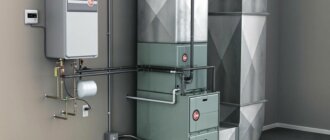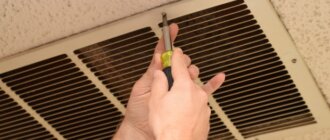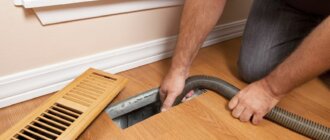
Common Problems with Electric Furnace Thermostats and How to Troubleshoot Them
When it comes to heating your home, an electric furnace can be a reliable and efficient option. However, like any other appliance, electric furnaces can experience issues from time to time. One common problem homeowners encounter is thermostat issues. If your electric furnace is not responding to temperature adjustments or is not turning on or off as expected, it may be due to a faulty thermostat.
A thermostat is a device that controls the heating and cooling system in your home. It senses the temperature and signals the furnace to turn on or off to maintain the desired temperature. When the thermostat malfunctions, it can disrupt the proper functioning of your electric furnace, leading to discomfort and increased energy bills.
There are several potential thermostat issues that can occur. One common problem is a miswired thermostat, where the thermostat is not connected correctly to the furnace. This can result in incorrect temperature readings and improper functioning of the furnace. Another issue is a malfunctioning thermostat sensor, which may not accurately detect the temperature in your home, causing the furnace to cycle on and off unnecessarily.
Fortunately, many thermostat issues can be resolved with some troubleshooting and basic repairs. In this article, we will explore common electric furnace thermostat issues and provide step-by-step instructions on how to fix them. By understanding these common problems and their solutions, you can save time and money by resolving thermostat issues on your own.
Why is my furnace not turning on for heat?
There can be several reasons why your furnace is not turning on for heat. Here are some common issues and their possible solutions:
| 1. Thermostat setting | Check if the thermostat is set to the desired temperature and mode (heat). Make sure it is not set too low or in cooling mode. |
| 2. Power supply | Ensure that the furnace is receiving power. Check the circuit breaker or fuse box to make sure the power supply is not interrupted. |
| 3. Pilot light | If you have a gas furnace, check if the pilot light is lit. If not, follow the manufacturer’s instructions to relight it. |
| 4. Dirty air filter | A clogged air filter can restrict airflow and cause the furnace to shut off. Replace the air filter if it is dirty or blocked. |
| 5. Faulty ignition system | If your furnace has an electronic ignition system, it may be malfunctioning. In this case, it is recommended to call a professional technician to diagnose and repair the issue. |
| 6. Blower motor problems | A malfunctioning blower motor can prevent the furnace from turning on. Check if the motor is running and if not, contact a professional for assistance. |
| 7. Gas supply | If you have a gas furnace, ensure that the gas supply is turned on and the gas valve is open. If there is a problem with the gas supply, consult a professional. |
If you have checked all these possible causes and your furnace still does not turn on, it is best to contact a qualified HVAC technician for further inspection and repair.
Dead thermostat batteries
If your electric furnace thermostat is not working, the first thing you should check is the batteries. Many thermostats rely on batteries for power, and if the batteries are dead, the thermostat will not function properly.
To fix this issue, start by removing the thermostat cover and checking if it has batteries. If it does, replace them with fresh ones. Make sure to use the correct type of batteries as specified by the manufacturer.
After replacing the batteries, put the thermostat cover back on and test if it is working. You may need to reset the thermostat or adjust the settings to ensure it is functioning correctly.
If the thermostat still does not work after replacing the batteries, there may be a different issue causing the problem. In this case, it is recommended to consult the manufacturer’s manual or contact a professional HVAC technician for further assistance.
Loose wiring connections
One common issue that can cause problems with an electric furnace thermostat is loose wiring connections. Over time, the wires connecting the thermostat to the furnace can become loose or disconnected, resulting in a loss of communication between the two. This can lead to the thermostat not sending the correct signals to the furnace, causing it to malfunction.
To fix this issue, you will need to check the wiring connections between the thermostat and the furnace. Start by turning off the power to the furnace at the circuit breaker. Then, remove the thermostat cover to access the wiring. Inspect the wires to see if any are loose or disconnected.
If you find any loose wires, use a screwdriver to tighten the connections. Make sure the wires are securely fastened to the terminals on both the thermostat and the furnace. If any wires are disconnected, reconnect them to their respective terminals.
Once all the wiring connections are secure, replace the thermostat cover and turn the power back on at the circuit breaker. Test the furnace to see if it is now functioning properly. If not, you may need to consult a professional HVAC technician to further diagnose and repair the issue.
Note: It is important to exercise caution when working with electrical connections. If you are unsure or uncomfortable working with electrical components, it is best to seek professional assistance.
Failed thermostat
If your electric furnace is not turning on or off as it should, the problem could be a failed thermostat. The thermostat is responsible for sensing the temperature and signaling the furnace to turn on or off accordingly. If the thermostat is faulty, it may not accurately sense the temperature or send the correct signals to the furnace.
To determine if the thermostat is the issue, first check if it is properly set to the desired temperature. Make sure the thermostat is set to “heat” mode and the temperature is set higher than the current room temperature. If the furnace still does not turn on, try adjusting the temperature to a higher setting to see if it responds.
If the thermostat is non-responsive or does not seem to be functioning correctly, it may need to be replaced. Before replacing the thermostat, check if it has any batteries that need to be replaced. Some thermostats require batteries for operation, and a low battery can cause malfunctions.
If the thermostat does not have batteries or replacing them does not solve the issue, you will likely need to purchase a new thermostat. When replacing the thermostat, make sure to turn off the power to the furnace before starting any work. Follow the manufacturer’s instructions for installing the new thermostat, or consider hiring a professional if you are not comfortable doing it yourself.
Remember to choose a compatible thermostat for your electric furnace. Look for a thermostat that is designed for use with electric furnaces and has the necessary features for your needs, such as programmable settings or Wi-Fi connectivity.
Replacing a failed thermostat should resolve any issues related to temperature control and ensure that your electric furnace operates efficiently.
How do I know if my thermostat is not working?
If you suspect that your electric furnace thermostat is not working properly, there are a few signs you can look out for:
| 1. No power | If the thermostat display is blank and there is no power, it could be a sign that the thermostat is not working. |
| 2. Incorrect temperature readings | If the temperature displayed on the thermostat does not match the actual temperature in the room, it may indicate a problem with the thermostat. |
| 3. Inconsistent heating or cooling | If your electric furnace is not heating or cooling consistently, it could be due to a faulty thermostat that is not accurately controlling the temperature. |
| 4. Constant cycling | If your furnace is constantly turning on and off, it could be a sign that the thermostat is not functioning properly and is causing the furnace to cycle too frequently. |
| 5. Unresponsive controls | If the buttons or controls on your thermostat are not responding when pressed, it could indicate a malfunctioning thermostat. |
If you notice any of these signs, it is recommended to troubleshoot the thermostat or consult with a professional HVAC technician to diagnose and fix the issue.
No power lights illuminated
If the power lights on your electric furnace thermostat are not illuminated, there are several potential causes and solutions to consider:
1. Check the power source
Make sure that the thermostat is properly connected to a power source. Check the circuit breaker or fuse box to ensure that power is reaching the thermostat. If the power source is functioning properly, move on to the next step.
2. Check the thermostat wiring
Inspect the wiring connections between the thermostat and the furnace. Look for any loose or damaged wires that may be preventing power from reaching the thermostat. If you find any issues, tighten or replace the wires as necessary.
3. Replace the batteries
If your thermostat uses batteries, check if they need to be replaced. Dead or low batteries can cause the power lights to not illuminate. Replace the batteries with fresh ones and see if the power lights come on.
4. Reset the thermostat
Try resetting the thermostat by turning off the power to the furnace and then turning it back on after a few minutes. This can help reset any internal settings that may be causing the power lights to not illuminate.
5. Consult a professional
If none of the above solutions work, it may be best to consult a professional HVAC technician. They can diagnose and fix any underlying issues with the thermostat or furnace that may be causing the power lights to not illuminate.
By following these troubleshooting steps, you should be able to determine the cause of the no power lights illuminated issue with your electric furnace thermostat and find an appropriate solution.
Settings not adjusting temperature
If your electric furnace thermostat settings are not adjusting the temperature properly, there could be a few possible causes:
1. Incorrect thermostat programming: Make sure that you have programmed the thermostat correctly. Check the user manual or manufacturer’s instructions to ensure that the settings are properly adjusted for your desired temperature.
2. Faulty thermostat: If the thermostat is old or damaged, it may not be able to properly communicate with the furnace. In this case, you may need to replace the thermostat with a new one.
3. Wiring issues: Check the wiring connections between the thermostat and the furnace. Loose or damaged wires can prevent the thermostat from properly adjusting the temperature. If you notice any issues with the wiring, it is recommended to call a professional electrician to fix it.
4. Furnace problems: It is also possible that the issue lies with the furnace itself. If the furnace is not functioning correctly, it may not respond to the thermostat settings. In this case, it is best to contact a professional HVAC technician to diagnose and fix the problem.
If you are unsure about how to troubleshoot or fix any of these issues, it is always recommended to seek professional help. A qualified technician will be able to diagnose the problem accurately and provide the necessary repairs or replacements.
Note: Always exercise caution when working with electrical components. If you are not comfortable or experienced with electrical work, it is best to leave it to the professionals.
Unresponsive display
If your electric furnace thermostat display is unresponsive, it could indicate a problem with the power supply or a malfunctioning thermostat. Here are a few steps you can take to troubleshoot and fix the issue:
- Check the power supply: Make sure that the thermostat is receiving power. Check the circuit breaker or fuse box to ensure that the breaker hasn’t tripped or the fuse hasn’t blown. If necessary, reset the breaker or replace the fuse.
- Inspect the wiring: Examine the thermostat wiring to ensure that there are no loose or damaged connections. If you find any issues, tighten or replace the wires as needed.
- Replace the batteries: If your thermostat uses batteries, try replacing them with fresh ones. Weak or dead batteries can cause the display to become unresponsive.
- Reset the thermostat: Some thermostats have a reset button that you can press to restore the default settings. Refer to the manufacturer’s instructions to locate and use the reset button, if applicable.
- Consider a professional inspection: If none of the above steps resolve the issue, it may be best to contact a professional HVAC technician. They can diagnose and repair any underlying problems with the thermostat or the furnace.
By following these troubleshooting steps, you should be able to determine the cause of the unresponsive display on your electric furnace thermostat and take the necessary steps to fix it.
Why is the thermostat not turning on the heat?
If your electric furnace thermostat is not turning on the heat, there could be several reasons for this issue. Here are a few possible causes:
1. Incorrect temperature setting: Double-check that the thermostat is set to a higher temperature than the current room temperature. If the desired temperature is lower than the current room temperature, the thermostat will not activate the heat.
2. Power supply issues: Ensure that the thermostat is receiving power. Check if the circuit breaker or fuse connected to the furnace is tripped or blown. If so, reset the breaker or replace the fuse. Additionally, make sure the thermostat is securely connected to the electrical wiring.
3. Dead batteries: If your thermostat is battery-powered, the batteries might be dead. Replace them with fresh batteries and see if that resolves the issue.
4. Faulty thermostat: It’s possible that the thermostat itself is faulty. Test the thermostat by turning on the heat manually using the furnace controls. If the heat turns on, the issue might be with the thermostat. Consider replacing it with a new one.
Note: If you are unsure about handling electrical components or if the issue persists after trying these troubleshooting steps, it’s recommended to consult a professional HVAC technician for assistance.
Incorrect temperature threshold set
If your electric furnace thermostat is not working properly, one possible issue could be an incorrect temperature threshold set. The temperature threshold refers to the desired temperature at which the thermostat should turn on or off the furnace. If this threshold is set too high or too low, it can result in the furnace not turning on or off at the appropriate times.
To fix this issue, you’ll need to adjust the temperature threshold on your thermostat. Start by accessing the thermostat settings menu. This can usually be done by pressing a specific button or combination of buttons on the thermostat itself. Consult the user manual for your specific thermostat model if you are unsure how to access the settings menu.
Once you’ve accessed the settings menu, look for the temperature threshold or temperature differential option. This option will allow you to adjust the desired temperature at which the furnace should turn on or off. Use the arrow keys or buttons on your thermostat to increase or decrease the temperature threshold as needed.
It’s important to note that the temperature threshold may be displayed in Fahrenheit or Celsius, depending on your thermostat settings. Make sure you are adjusting the threshold to the desired temperature scale.
After making the necessary adjustments, exit the settings menu and observe the furnace’s behavior. It should now turn on or off at the correct temperature threshold. If the issue persists, you may need to consult a professional HVAC technician to further diagnose and fix the problem.
Remember: Incorrect temperature threshold settings can cause your electric furnace to not heat or cool your home effectively, so it’s important to ensure that it is set correctly for optimal performance.
Malfunctioning temperature sensor
If your electric furnace thermostat is not functioning properly, it could be due to a malfunctioning temperature sensor. The temperature sensor is responsible for detecting the current temperature of the room and sending that information to the thermostat.
If the temperature sensor is faulty, it may not be able to accurately measure the room temperature, resulting in incorrect temperature readings on the thermostat. This can lead to the furnace not turning on or off when it should, causing discomfort and potentially wasting energy.
To fix this issue, you can try recalibrating the temperature sensor. Consult the manufacturer’s instructions for your specific thermostat model on how to do this. If recalibrating doesn’t work, you may need to replace the temperature sensor altogether.
Before replacing the temperature sensor, it’s important to ensure that it is indeed the cause of the problem. You can do this by checking the wiring connections between the temperature sensor and the thermostat. Make sure they are securely connected and not damaged. If the wiring appears to be in good condition, you can use a multimeter to test the resistance of the temperature sensor. If the resistance is significantly off from the expected value, it is likely a faulty sensor.
Replacing the temperature sensor is a relatively simple process. Start by turning off the power to the furnace. Then, locate the temperature sensor, which is usually mounted on the wall near the thermostat or inside the furnace itself. Disconnect the wiring from the old sensor and remove it. Install the new sensor by connecting the wiring and mounting it securely in place.
Once the new temperature sensor is installed, turn the power back on and test the thermostat to ensure that it is now accurately detecting the room temperature. If the issue persists, it may be worth contacting a professional HVAC technician to further diagnose and resolve the problem.
Short circuit in wiring
A short circuit in the wiring of an electric furnace thermostat can cause various issues, including the thermostat not working properly or not working at all. A short circuit occurs when there is an unintended connection between two or more wires, resulting in a flow of excessive current. This can lead to overheating, damage to the thermostat, or even a potential fire hazard.
To fix a short circuit in the wiring, it is important to identify the source of the problem. Here are some steps you can take:
| 1. Turn off the power: Before attempting any repairs, make sure to turn off the power supply to the furnace to avoid any electrical hazards. |
| 2. Inspect the thermostat wiring: Carefully inspect the thermostat wiring for any signs of damage, such as frayed or exposed wires. If you notice any issues, you may need to replace the wiring. |
| 3. Check for loose connections: Ensure that all connections are tight and secure. Loose connections can cause a short circuit and should be tightened or replaced if necessary. |
| 4. Use a multimeter: If you have a multimeter, you can use it to test for continuity and check for any short circuits. Follow the manufacturer’s instructions to perform the tests accurately. |
| 5. Repair or replace damaged components: If you find any damaged components or wires, you will need to repair or replace them. This may involve soldering or using wire connectors, depending on the extent of the damage. |
| 6. Test the thermostat: Once you have fixed the short circuit, test the thermostat to ensure it is functioning properly. Turn on the power and adjust the temperature settings to see if the furnace responds accordingly. |
It is important to exercise caution when working with electrical systems. If you are unsure or uncomfortable with performing the repairs yourself, it is recommended to seek assistance from a professional electrician.
By following these steps, you can address a short circuit in the wiring of your electric furnace thermostat and restore its functionality.
How can I test my thermostat?
If you suspect that your electric furnace thermostat is not working correctly, you can perform a few tests to determine if it needs to be replaced. Here are some steps you can take to test your thermostat:
| Test | Procedure |
|---|---|
| 1 | Check for power |
| 2 | Check for continuity |
| 3 | Check for temperature accuracy |
1. Check for power: First, make sure that your thermostat is receiving power. Check the circuit breaker or fuse box to ensure that the power to the furnace is on. If the furnace is receiving power but the thermostat is not, it may be a sign of a faulty thermostat.
2. Check for continuity: To test for continuity, use a multimeter to measure the resistance across the thermostat terminals. Set the multimeter to the ohms setting and touch the probes to the terminals. If the multimeter shows a reading of zero or close to zero, there is continuity, indicating that the thermostat is functioning properly. If there is no continuity, it may be a sign of a defective thermostat.
3. Check for temperature accuracy: If your thermostat has a temperature display, compare it to a separate thermometer to check for accuracy. Place the thermometer next to the thermostat and wait for a few minutes to allow them to adjust to the same temperature. If there is a significant difference in the readings, it may indicate a problem with the thermostat’s temperature sensor.
If you have performed these tests and suspect that your thermostat is not working correctly, it may be time to replace it. Consult the manufacturer’s instructions or contact a professional HVAC technician for assistance in replacing your electric furnace thermostat.
Check battery voltage
If your electric furnace thermostat is not working properly, one of the first things you should check is the battery voltage. Many thermostats require batteries to function, and if the batteries are dead or low on power, the thermostat may not work correctly.
To check the battery voltage, you will need a multimeter. Start by removing the thermostat from the wall and locating the battery compartment. Open the compartment and carefully remove the batteries.
Next, set your multimeter to the DC voltage setting and touch the positive (red) probe to the positive terminal of the battery and the negative (black) probe to the negative terminal. The multimeter should display the voltage reading.
If the voltage reading is below the recommended level, replace the batteries with fresh ones. Be sure to insert the batteries correctly, following the polarity markings in the compartment. Once the new batteries are installed, reattach the thermostat to the wall and see if it is functioning properly.
If the battery voltage is within the recommended range but the thermostat is still not working, there may be other issues at play. In this case, it is best to consult a professional HVAC technician to diagnose and fix the problem.
Checking the battery voltage is a simple and important step in troubleshooting electric furnace thermostat issues. By ensuring that the batteries are in good condition, you can eliminate one potential cause of the problem and move on to other troubleshooting steps if needed.
Inspect wire connections
One common issue that can cause problems with an electric furnace thermostat is loose or faulty wire connections. Over time, wires can become loose or frayed, leading to a loss of connection and causing the thermostat to malfunction.
To inspect the wire connections, first, turn off the power to the furnace at the circuit breaker. Then, remove the thermostat cover to access the wiring. Carefully examine each wire to ensure it is securely connected to the appropriate terminal on the thermostat. If you notice any loose or damaged wires, tighten or replace them as necessary.
It’s also important to check the wiring connections at the furnace itself. Make sure all wires are securely connected to their respective terminals and that there are no signs of damage or corrosion. If you find any issues, tighten or replace the wires as needed.
After inspecting and securing all wire connections, reattach the thermostat cover and restore power to the furnace. Test the thermostat to see if the issue has been resolved. If not, further troubleshooting may be required.
Replace thermostat to test
If you have tried all the previous troubleshooting steps and are still experiencing issues with your electric furnace thermostat, it may be necessary to replace the thermostat to determine if it is the source of the problem.
Before replacing the thermostat, make sure to turn off the power to your electric furnace to avoid any electrical shock. Remove the cover of the thermostat by unscrewing it from the wall or popping it off, depending on the model.
Once the cover is removed, take note of the wires connected to the thermostat terminals. It is a good idea to take a picture or make a diagram of the wiring configuration for reference later.
Disconnect the wires from the old thermostat by loosening the terminal screws and gently pulling the wires out. Be careful not to damage the wires in the process.
Install the new thermostat by connecting the wires to the corresponding terminals. Make sure to match the wire colors with the terminal labels to ensure proper connection.
Once the wires are securely attached, place the new thermostat onto the wall and screw it in or snap it into place. Make sure it is level and flush with the wall.
Restore power to your electric furnace and turn on the thermostat. Follow the manufacturer’s instructions for setting the desired temperature and programming any necessary settings.
If the new thermostat functions properly and controls your electric furnace as expected, then the issue was likely with the old thermostat. If the problem persists, it may be necessary to consult a professional HVAC technician to further diagnose and resolve the issue.
Remember to always exercise caution when working with electrical components and consider seeking professional help if you are unsure or uncomfortable performing any of these steps.
Q&A:
Why is my electric furnace not turning on?
There could be several reasons why your electric furnace is not turning on. Firstly, check if the thermostat is set to the correct temperature and mode. If it is, then you may need to check the circuit breaker and ensure that it is not tripped. Additionally, a faulty thermostat or a problem with the wiring could also be the cause.
How can I test if my electric furnace thermostat is functioning properly?
To test if your electric furnace thermostat is functioning properly, you can try increasing or decreasing the temperature setting. If you hear a clicking sound from the thermostat and the furnace turns on or off accordingly, then it is likely working fine. However, if there is no response or the temperature does not change, then the thermostat may need to be replaced.
Why is my electric furnace constantly running?
If your electric furnace is constantly running, it could be due to a few reasons. Firstly, check if the thermostat is set to the “ON” position instead of “AUTO”. If it is set to “ON”, the fan will continue to run even when the desired temperature is reached. Another possible cause could be a faulty thermostat or a problem with the wiring.
What should I do if my electric furnace is producing insufficient heat?
If your electric furnace is producing insufficient heat, there are a few things you can try. Firstly, check if the thermostat is set to the desired temperature and mode. If it is, then you may need to clean or replace the air filter, as a dirty filter can restrict airflow and reduce heat output. Additionally, check if the circuit breaker is not tripped and ensure that the heating elements are functioning properly.
Why is my electric furnace not turning off?
If your electric furnace is not turning off, it could be due to a few reasons. Firstly, check if the thermostat is set to the correct temperature and mode. If it is, then the problem may lie with the thermostat itself. A faulty thermostat or a problem with the wiring can cause the furnace to continue running even when the desired temperature is reached.



